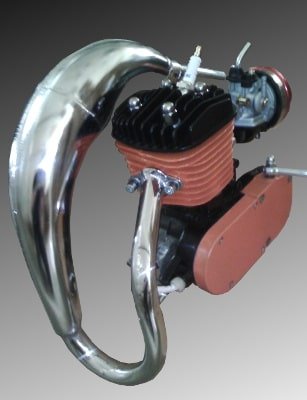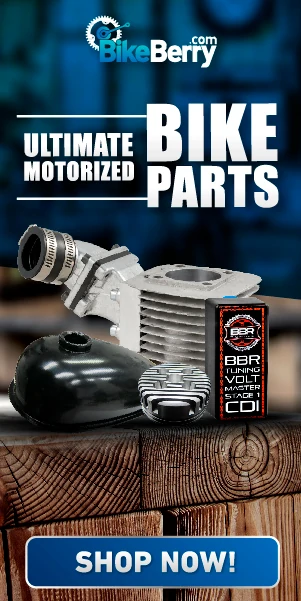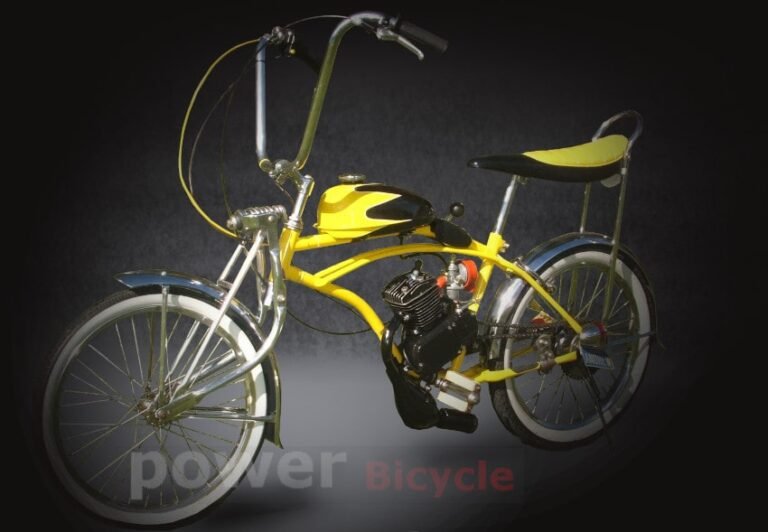Motorized Bicycles Engine Tuning
The Ultimate guide to tuning a 2-stroke bicycle motor
TUNING A MOTORIZED BICYCLE
Not only is it enjoyable to build a motorized bicycle, but 2-stroke engines are great fun to tune.
I detail best practice, and the most cost effective approach, to tuning 2-stroke bicycle engines.
Although I focus on tuning bicycle motors, the same principles can be used to great effect with any 2-stroke engine.
If you prefer to have a graphical representation of tuning fundamentals then click here for a 2 stroke tuning infographic.
WHAT SPEED CAN MOTORIZED BICYCLE GO ?
How Fast Can A 50cc Motorized Bicycle Go?
Owners who have fitted an untuned 50cc bicycle motor expect to reach speeds between 25 to 35 MPH. With tuning, we can cost effectively obtain top speeds close to 55 MPH.

How Fast Can An 80cc Motorized Bicycle Go?
80cc motorized bicycles, surprisingly, are often slightly slower than 50cc bicycle motors. Before tuning, 80cc bicycle engines can obtain speeds of 28 to 33 MPH. With a few performance parts, 80cc bicycle motors can reach speeds of 60 MPH.
80cc motors also maintain better speed on hills, and accelerate faster than smaller bicycle engines.
How Fast Can A 100cc Motorized Bicycle Go?
Until recently, 100cc bicycle motors were no faster than 80cc engines. Recent improvements in 100cc bicycle engines has seen an improvement in speed. Simply by fitting a smaller rear sprocket, a 100cc bicycle motor is expected to reach speeds of 32 to 38 MPH.
Back when MotoGP was focused on racing 2-Strokes, I spoke in depth with a tuning specialist from the Suzuki factory racing team. He was purchasing a 50cc bicycle motor kit from me for a project he wanted to build.
The Suzuki tuning specialist believed that he could tune a 50cc bicycle motor to reach over 100 MPH.
I had no doubt that he would have been able to achieve this speed if he had set his mind to it, however, I’m sure that the cost to achieve 100 MPH would be prohibitive.
When tuning any engine, unfortunately, the law of diminishing returns soon kicks in.
Initially, substantial boosts in performance can be achieved at relatively low cost. As we continue to tune the motor, additional performance becomes smaller, more difficult to obtain, and relatively more expensive.
The good news is that a number of straight forward concepts can boost power output by over 50% very quickly, and relatively cheaply. It is quite feasible for a bicycle with a 50cc motor to reach 45 MPH with relatively few adjustments.
If you follow all these tuning guidelines, motorized bicycles are capable of achieving speeds approaching 60 MPH.
It is worth pointing out that at these speeds, lightweight bicycles with motors can become unstable and upgraded brakes are essential.
It is important to point out that tuning a bicycle motor is very different from tuning a pit bike engine. The limiting factor of tuning a bicycle motor is the maximum speed to which the crank can spin.
Bicycle motors spin up to around 4,000 RPM in standard form. When we start to tune the motor, most 80cc and 100cc engines start to vibrate badly at around 4,500 RPM. 50cc motors have less weight in their piston and crank and typically rev to around 5,000 RPM.
Our goal when tuning bicycle motors is primarily to increase torque rather than revs. When we have a higher torque motor, we fit a smaller rear sprocket. Higher torque motors with a small rear sprocket have increased top speed, pull away from lights better, and retain momentum up hills.
TUNING CHECKLIST
There is a logical order to follow when augmenting the performance of a 2-stroke engine:
- Modify the muffler or fit an expansion chamber
- Tune the carburettor
- Replace the rear sprocket
- Barrel porting
- Fit a performance cylinder head
ADDITIONAL PERFORMANCE OPTIONS
- Reed valve redesign
- Increase the cubic capacity of your motorized bicycle.
EXPANSION CHAMBERS
The majority of expansion chambers for bicycle motors are cheaply constructed and built for appearance rather than performance. Low cost expansion chambers pay little attention to performance.
Choosing the best expansion chamber for a motorized bicycle can, therefore, be a challenge.
Although the power boost falls far short of the expectation of a well tuned pipe, in most cases, low cost chambers do provide some performance benefits.
There is no baffling in any expansion chamber. The baffle free pipe improves the flow of exhaust gasses which is usually sufficient to aid performance. A properly tuned expansion chamber will, however, make a dramatic difference to the performance of your motorized bike.
TUNED POWER PIPES FOR BICYCLE MOTORS
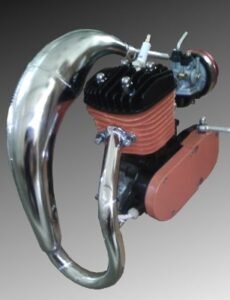
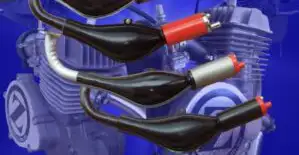
The most common low cost pipe is the “Banana Pipe”. This pipe gets its name from the shape of the expansion chamber which resembles a banana. These pipes are very poor designs and seldom deliver much of a power boost.
Properly tuned expansion chamber should be constructed with precise length, inlet and outlet apertures, chamber volumes and angles.
It is important to understand that good expansion chambers are tuned to add most power at a given rev range. The power boost reduces below and above the tuned revs (the resonant frequency).
The best expansion chambers have a length adjustment. Being able to adjust the pipe length provides some control of where peak power occurs.
A low cost expansion chamber for a motorized bicycle will cost around $30, with top flight, well tuned expansion chambers selling for over $150.
THE FREE ALTERNATIVE TO AN EXPANSION CHAMBER
There is a low cost alternative to fitting an expansion chamber. If you don’t want to pay for a power pipe, or you find them annoyingly loud, you can cut the stinger pipe inside the muffler.
Remove the end cap from the muffler and cut around 1” off the end cap pipe (The end cap is often referred to as the ‘stinger’).
Shortening the stinger will provide a noticeable increase in power. You can usually obtain maximum benefit by removing 1 1/2” from the pipe.
Be aware that performance will begin to drop off if you cut too much off the stinger pipe.
Most bicycle motors kits are supplied with an NT carburetor. Although the NT is a very basic carb, it is extremely effective when properly tuned.
Tuning the NT carburetor does not usually require any additional parts although a variety of carburetor fuel jets can be helpful. NT carb settings can be changed in just a few minutes.
Refer to the NT Carburettor tuning guide here.
The reason that the carburettor tuning is not the first item on our tuning schedule is that carburettor settings often change after fitting an expansion chamber.

A popular carburettor upgrade for motorized bicycles is the Rongtong carburettor. The Rongton carb. is better constructed, and more sophisticated, than the NT carburettor. In addition, the conical air filter and distinctive metallic colors look sharp.
This carburettor provides easier starting, a convenient hands free choke cut-off, and a more consistent fuel:air mixture throughout the rev range.
There are no adjustments on the Rongtong carb. There are no mixture screws, metering needle adjustments, and fuel jets cannot be accessed.
All bicycle engine kits are supplied with a 44 tooth rear sprocket as standard. This is true whether you purchase a 50cc, 80cc or 100cc engine kit. The 44 tooth sprocket provides a good balance between speed and torque for standard motors.
Now that we have begun to tune our engine, the increased engine torque allows a smaller rear sprocket to be fitted.
There are a variety of aftermarket rear sprockets available. A larger sprocket will reduce your cruise speed but be stronger on hills.
Smaller rear sprockets provide a higher cruise speed for the given engine RPM. The most popular “speed” sprocket is a 36 tooth unit. A 36 tooth sprocket will increase speed by 22% for any given RPM.
36 tooth “speed” sprockets can be purchased for around $25.
Gas flow through any engine is an effective way to improve performance and 2 stroke engines are particularly sensitive to gas flow.
Wherever possible, any ridges, or imperfections in exhaust and transfer ports should be filed smooth.
A popular misconception is that polishing the inlet port is also beneficial to performance. Rather than smoothing the Inlet port, however, a rough and imperfect surface will benefit performance.
The reason for a roughened inlet port is that turbulence in the inlet port helps the fuel:air from the carburettor to mix and vaporize more effectively.
Better mixed fuel air helps the combustion process.
Barrel porting is a favored method of tuning pit bike engines. Raising the exhaust port and transfer ports on a 2 stroke motor will typically raise the RPM at which peak engine power is produced. The downside of raising the port height is that it narrows the effective power band.
In general, we can increase power at peak RPM but this reduces torque at lower revs. In other words, we gain higher revs but reduced acceleration.
Useful speed and acceleration gains can, however, be obtained by reshaping ports for better effect. There are many experts who experiment with a variety of port shapes and heights. Different experts have their own opinion on the best piston shape and height.
There is also a mass of software available that can optimize port shape and height to achieve best effect. There are a number of calculators available online and there are even apps available in the App store and Google Play.
Barrel porting is a very useful tuning tool, however, bear in mind the rev limit of bicycle motor cranks. Barrel porting is not the be all and end all of tuning a bicycle motor.
If you do not want to risk modifying your barrel ports, a simple, and non destructive method of raising piston ports is to add an existing base gasket (or two) to the bottom of the barrel.
Adding one or two gaskets will raise all ports by half a millimetre or so. This is sufficient to provide a small power boost while not exceeding the limits of the crankshaft.
Raising exhaust and transfer ports will reduce compression in the combustion chamber. This is where a high compression head can be beneficial.
There are a whole range of benefits to fitting a CNC cylinder head: Better cooling, improved squish band, perfect spark plug position, and bell shaped combustion chamber.
Refer to this performance cylinder head article for more information.
The tuning steps that we have covered so far, cover fundamental tuning. At this stage, your motorized bike should reach speeds between 50 and 60 MPH.
Further cost effective tuning is possible, however, further stages require more effort, greater cost, or return marginal performance improvements.
REED VALVE
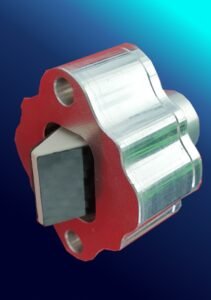
Reed valves can substantially lift performance and reed valves for bicycle motors are available from around $35.
The reed valve by itself does little to improve performance. Adding a reed valve will, however, allow the extended duration of the inlet port.
Extending the inlet port duration allows the motorized bicycle to take in much more fuel:air.
As this is a complex topic. I cover reed valves in a separate section.
Additional displacement is always a great way to increase the torque of an engine. There will not be a substantial speed difference between an 80cc bicycle motor and a 100cc bicycle motor.
If you have perhaps been overzealous with cutting transfer ports or you have damaged the barrel or piston, this is an ideal opportunity to upsize your engine.
If you are interested in the benefits of upgrading to a 100cc motorized bicycle, follow this link
Additional High Performance Parts
There are other high performance parts available to us
- Power ignition
- Bell air intake
- NOS (with some reservations)
- Boost Bottles
Power Ignition systems (CDI)
Power ignition systems provide a stronger spark. These ignitions provide the engine with a more responsive feel and are also helpful if your bicycle motor is difficult to start. They cost around $25, however, the performance benefit is subtle.
Bell shaped air intakes.
Bell shaped air intakes add a little torque and deepen the intake note which makes the engine sound better. The power benefit is subtle. Bell shaped air intakes look flash, sound great and cost around $15.
NOS
Nitrous Oxide Systems are available for bicycle engines. Surprisingly, they only cost around $45 and work well for short bursts. After a second or two of power boost, the engine begins to stutter and backfire.
I have not included NOS systems in this tuning guide as they can be harmful to the bicycle engine.
Boost Bottles
I have tested boost bottles extensively and could find no performance improvement. The concept does, however, deepen the intake note.
The boost bottle principle has provided benefits to high performance 2 stroke engines, however, on expensive, high performance engines, rigorous design has gone into ensuring that they are properly tuned.
It may be possible to fine tune boost bottles to enhance performance, however, I have never been able to obtain any benefit from them.
CONCLUSION
When tuning a motorized bicycle, the law of diminishing returns applies. As we continue to tune the motor, additional performance increments become smaller, more difficult to obtain, and more expensive.
It is important to point out that tuning a bicycle motor is very different from tuning a high performance motorcycle engine.
The limiting factor of tuning a bicycle motor is the maximum speed to which the crank can spin. When we tune a bicycle motor, most 80cc and 100cc engines begin to vibrate destructively at around 4,500 RPM.
There are a number of straightforward concepts that can quickly and cheaply boost power output by over 50%.
- Modify the muffler or fit an expansion chamber
- Tune the carburettor
- Replace the rear sprocket
- Polish and port the barrel
- Fit a performance cylinder head
By following the guidelines in this article, it is quite feasible for a motorized bicycle to reach 60MPH.
The above links provide connections to the easy to understand articles on this site. The concepts are all specific to increasing the performance of bicycle motors. If you want to go to greater technical detail about the articles, a click here for an in-depth academic paper on 2 stroke tuning.
